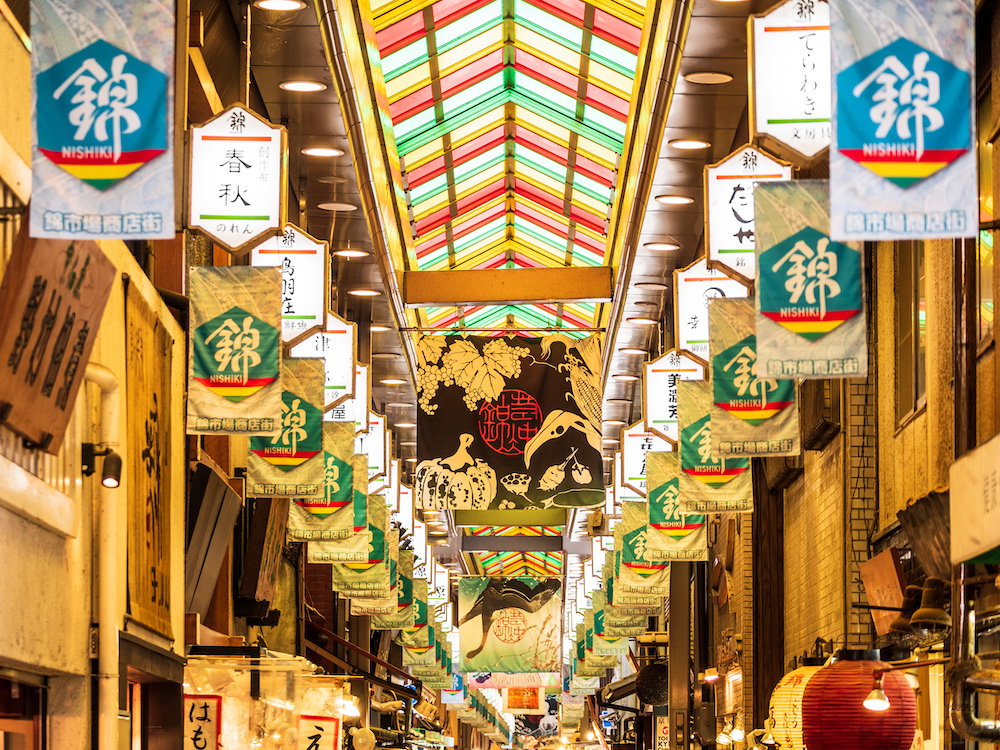
Kansai
The region consists of the prefectures of Wakayama, Nara, Kyoto, Osaka and Hyogo.
-

Nishiki Market | Kyoto Travel Guide
The best way to learn about everyday Japanese life and what people like to cook at home is to visit one of its many food markets. Nishiki Market is in the center of Kyoto, and a popular market to visit for tourists.
-

Horyuji Temple | Nara Travel Guide
The Horyuji temple in Nara was founded in 607 by Prince Shotoku and has the oldest wooden buildings in the world.
-

Nara National Museum
Nara National Museum is located in Nara Park where you can also see famous temples such as Todaiji Temple and Kohukuji. The museum exhibits mainly Buddhist art.
-

Kofukuji Temple | Nara Travel Guide
The Kofukuji Temple was moved to its current location in Nara from Kyoto in 710, the year when the capital was moved to Nara. The pagodas and the museum are worth a visit.
-

Kasuga Taisha | Nara Travel Guide
Kasuga Taisha Shrine was founded in the 8th century by the Fujiwara family and used to be completely rebuilt every 20 years, according to Shinto tradition, until the end of the 14th century.
-

Hasedera Temple | Nara Travel Guide
Various kinds of flowers blooming throughout the year on Hasedera’s grounds, the temple has been nicknamed ‘Flower temple’ since ancient times. I especially love to visit the Hasedera to view the hydrangea in the early summer season.
-

Todaiji Temple | Nara Travel Guide
The Todaiji Temple is located in the famous Nara Park and is the world’s largest wooden structure. Discover more about its long history!
-

Byodoin Temple | Kyoto Travel Guide
The Byodoin temple is the most famous landmark in a part of Kyoto that is especially known for its green tea production, Uji. The image of the temple is very well-known throughout Japan.
-

Kodaiji Temple | Kyoto Travel Guide
Kodaiji Temple is located in Higashiyama. It was founded in 1605 by Kita-no-Mandokoro as a memorial to her husband, Toyotomi Hideyoshi, who was one of the most important men of his time.
-

Heian Jingu | Kyoto Travel Guide
The Heian Jingu shrine was instituted in 1895 to commemorate the 1,100-year anniversary of the return of the capital to Heian, which is today’s Kyoto. Its architecture is impressive.
-

Sanjusangendo | Kyoto Travel Guide
The Sanjusangendo temple in Kyoto was established by the powerful warrior-politician Taira-no-Kiyomori in 1164, and it is especially famous for its 1001 statues.
-

Gion | Kyoto Travel Guide
Gion is the place where the famous geisha, the cultural symbol of Japan, are still doing their work every night. Geisha literally means ‘artist’, although in Kyoto they are called ‘geiko’ which means ‘woman of art’.
-

Chionin Temple | Kyoto Travel Guide
The Chion-in temple in Kyoto is a Buddhist temple and is the home of Jo-do Buddhism. It was founded in the 12th century, and besides its historical significance, there are a few other reasons why this is an interesting temple to visit!
-

Tofukuji Temple | Kyoto Travel Guide
One of my favorite Zen temples is the Tofukuji temple located in the east of Kyoto city. What makes this temple very special are its magnificent landscapes of maple trees and cherry blossoms.
-

Kitano Tenmangu Shrine | Kyoto Travel Guide
The shrine of Kitano Tenmangu was built in the 10th century by the emperor of the time in honor of a scholar and politician. Now, it is especially known for its popular flea market.
-

Ryoanji Temple | Kyoto Travel Guide
Ryoan-ji is a Zen temple located in Kyoto which was built by a minister of the Ashikaga Shogunate in 1450. The temple is especially famous for its stone landscape garden.
-

Fushimi Inari Taisha | Kyoto Travel Guide
Known worldwide for its more than 10,000 torii gates in a row, the Fushimi Inari Taisha shrine attracts around 3 million visitors the first three days of the year alone and is one of the most famous attractions of Kyoto.
-

Toji Temple | Kyoto Travel Guide
Toji means Eastern Temple, and this temple in Kyoto has a very long history. The religious foundations of Kyoto were laid here, and Buddha has protected the city from where Kukai founded the temple since 796.
-

Ginkakuji Temple | Kyoto Travel Guide
Ginkakuji (Silver Pavilion) was constructed by a shogun from the 15th century. You can still see his quest for beauty in the Ginkakuji, even after 500 years.
-

Kyoto City | Kyoto Travel Guide
Kyoto is often called “the heart of Japan” and it is said that it would be impossible to get to know the country without visiting this wonderful city.
